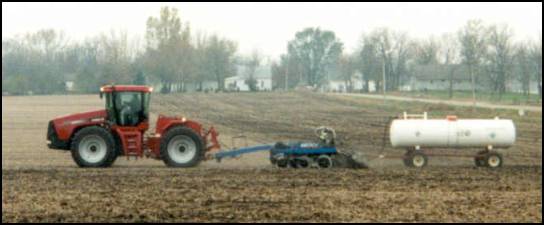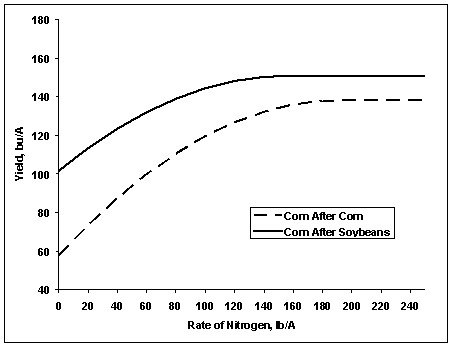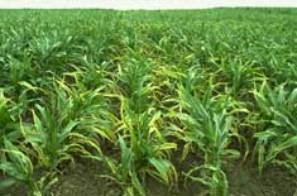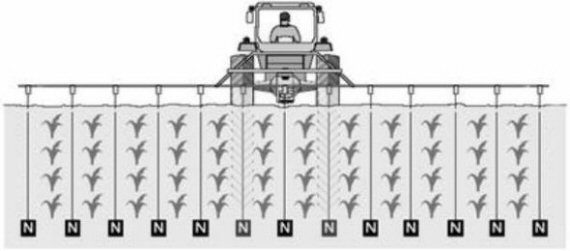VALUE OF MORE UNIFORM N APPLICATION ACROSS THE TOOLBARBy Bruce Erickson, Jess Lowenberg-DeBoer, and Fulgence Mishili, Department of Agricultural Economics, Purdue University. LEARNING OBJECTIVESUpon completion of this unit, you should be able to:
PRE-TEST
|
||||||||||||||||||||||||||||||||||||||||||||||||||||||||||||||||||||||||||||||||||||||||||||||||||||||||||||||||||||||||||||||||||||||||||||||||||||||||||||||||||||||||||||||||||||||||||||||||||||||||
INTRODUCTIONIn an era where the interest in crop inputs is about site specificity, is there any place for uniformity? Whether site-specific or not, the key is to try to match the amount of input to the optimum amount needed in specific portions of fields. If you have site-specific information to guide site-specific applications of inputs, then you can optimize application in each portion of a field. If you don’t have site-specific information, then a uniform application will most closely match what is needed across a field. It’s not good to add variability to variability! Interestingly, many growers apply one of their most important crop inputs in a very un-precise way. Anhydrous ammonia (Figure 1) has some unique safety issues, but is an important source of nitrogen because it is generally the least expensive, and has some favorable agronomic characteristics as well. Upon application to the soil, anhydrous ammonia quickly converts to the ammonium form, a positively charged ion that is held tightly by soil particles. In the past, ammonia has been especially inexpensive compared to other inputs and crop returns, thus any lack of application uniformity was usually masked by over-application to ensure minimums across a field. But with nitrogen prices elevating in recent years and increasing environmental concerns, there’s greater interest in ensuring that nitrogen is being applied more precisely. A recent study by the University of Nebraska showed that an application error among different parts of fields of 16% was typical. In this study, it was noted that some portions of a field could receive 16% more than intended, and other portions of fields could receive 16% less than intended. On a smaller scale but equally important is variation across the toolbar. One of the most common yet difficult to manage sources of variation in ammonia applications are the differences from knife to knife across the toolbar. Most of this variation originates in the manifold, where the ammonia is divided to go into each row. Iowa State University research shows knife outlet differences ranging from 4 to 16%, depending on the rate of nitrogen and the type of manifold used.
Figure 1. Applying anhydrous ammonia in the fall for corn following soybeans (Iowa State University). |
||||||||||||||||||||||||||||||||||||||||||||||||||||||||||||||||||||||||||||||||||||||||||||||||||||||||||||||||||||||||||||||||||||||||||||||||||||||||||||||||||||||||||||||||||||||||||||||||||||||||
NITROGEN ECONOMICSOn average, corn response to nitrogen can be illustrated by diminishing returns (Figure 2). The rate of nitrogen to apply, though, is complicated, since the soil is a reservoir of nitrogen, but the amount available to crops varies dramatically and is often very difficult to predict. Nitrogen can exist in different forms in the soil, and can be quite mobile, depending on the form. Nitrogen rate recommendations are partially based on nitrogen response curves generated from research studies. For Indiana and most Eastern Corn Belt states corn N rates are based on yield goals, with adjustments made for various crops that precede corn that may contribute soil N through symbiotic nitrogen fixation, or by additions of animal manures or other N sources. To maximize returns, the optimum rate of nitrogen is that point where the last pound of N is just paid for by the yield increase from that N. This is the economic optimum, the point producers should target when deciding input rates. But since nitrogen has been a relatively inexpensive input and there are so many factors that can influence responses, many growers also have not hesitated to exceed economic optimum rates, as a form of insurance to make sure their crop does not run out of nitrogen.
Figure 2. Nitrogen response curves for two crop rotations based 34 site/years, 1999-2003 (University of Illinois). |
||||||||||||||||||||||||||||||||||||||||||||||||||||||||||||||||||||||||||||||||||||||||||||||||||||||||||||||||||||||||||||||||||||||||||||||||||||||||||||||||||||||||||||||||||||||||||||||||||||||||
WHY IS IT DIFFICULT TO UNIFORMLY APPLY ANHYDROUS AMMONIA?Farmers have struggled with the precise application of anhydrous ammonia since it was first used in the 1940’s. For most agricultural applications, anhydrous ammonia is stored and transported prior to application as a liquid under pressure in a tank. With a boiling temperature of -28ºF, anhydrous ammonia converts to a gas as it leaves the pressurized tank in all but the very coldest of environmental conditions. Ammonia moves by its own pressure from the tank through the hose connections to the regulator, distribution manifold, and out to the injection knives. The pressure in the ammonia tank and in the regulating and metering devices depends on the temperature of the ammonia. Ammonia generally begins to boil as the pressure decreases in its travel through the system to the knife outlets, which are at zero pressure. Also as ammonia converts from a liquid to a gas (evaporates), it produces an intense cooling effect. Thus, the ammonia moving through the line is in a constant state of change of its temperature and pressure, and those ultimately determine whether it is in a liquid or a gaseous form. Ammonia gas occupies a volume that is about 800 times that of the same weight of ammonia that is a liquid. Since the metering devices for ammonia are based on volume but application precision should be based on weight (the amount of nitrogen), the ever-changing and complex mass of gaseous and liquid ammonia is a challenge to regulate. Flow toward some knives could have more gas and toward others more liquid ammonia, drastically affecting the actual amount of N applied per knife. |
||||||||||||||||||||||||||||||||||||||||||||||||||||||||||||||||||||||||||||||||||||||||||||||||||||||||||||||||||||||||||||||||||||||||||||||||||||||||||||||||||||||||||||||||||||||||||||||||||||||||
HOW CAN AMMONIA BE BETTER REGULATED?There are a number of common-sense techniques that have been used by producers and custom applicators to ensure more uniform N applications. Equal hose length between the manifold and each knife helps ensure equal friction loss as ammonia moves toward the ground. Kansas State University research indicates a flow reduction of as much as 10 percent when the length of some outlet hoses is doubled from 7 ft to 14 ft. In general, flow changes 1 to 2 percent per foot of hose length. Flow restrictors on outlet hose barbs will increase manifold pressure and decrease the effects from different hose lengths. Also, if hoses are all the same length and the hoses leading to knives near the manifold are coiled, the coils should be kept in a horizontal plane to prevent liquid ammonia from pooling in the lower parts of hose coils. A heat exchanger “cold flow” controller helps obtain the correct overall application rate per acre by measuring total system flow. Although overall “per acre” rates are accurately measured, downstream distribution problems may still exist. One of the greatest sources of application errors is associated with the distribution manifold. Unused manifold outlets should be plugged evenly around the perimeter so that ammonia leaving the manifold has an equal opportunity to depart. Even with uniformly plugged unused outlets in the manifold, Iowa State University testing shows great variation in output among various manifold types (Table 1).
Table 1. Manifold distribution variability of anhydrous ammonia, 1999-2002 (Iowa State University).
The average outlet difference in the table is the average difference of each outlet as compared to the mean of all outlets, expressed as a percentage. The high/low ratio is the maximum single outlet amount divided by the minimum single outlet amount. For example with the conventional manifold the N rate at the highest output outlet is about twice the rate at the lowest output outlet. Coefficient of variation (CV) is the standard deviation divided by the mean. A CV of 16.2% for 150 lb/A applied with a conventional manifold is equivalent to a standard deviation of about 25. A number of newer-style manifolds show significantly improved distribution compared to the conventional manifold. Still, a great amount of variation is occurring from row to row across the toolbar (Table 2).
Table 2. Example distribution of a seven-knife applicator applying 150 lb/A with a coefficient of variation of 16.2%.
A factor affecting the variability across the toolbar is the knife spacing of the applicator. It is common for corn roots to extend outward about three feet in all directions. If knives are in standard 30-inch spacings, each plant row should be able to access an average of two fertilizer bands, evening some of the row to row variability that a plant would experience. Some universities recommend 60-inch spacings to minimize soil disturbance and decrease horsepower requirements, yet wider spacings will likely result in more field variability in nitrogen application because it is more likely that a given corn plant will have access to N from only one knife. With narrower spacings (e.g. 15-inch) knife to knife variability would be less important because each corn plant would have access to N from three or four knives. |
||||||||||||||||||||||||||||||||||||||||||||||||||||||||||||||||||||||||||||||||||||||||||||||||||||||||||||||||||||||||||||||||||||||||||||||||||||||||||||||||||||||||||||||||||||||||||||||||||||||||
EFFECTS OF NON-UNIFORM AMMONIA APPLICATIONS ON YIELDAnhydrous ammonia applicators that do not apply nitrogen uniformly leave a variable rate pattern in a field. While some of the variation could be in a predictable pattern, much of it is randomly scattered across the field. The resulting variation in N rate likely will cause a corresponding variation in corn yields, and may even be apparent visually (Figure 3).
Figure 3. Nitrogen deficiency in corn (Univ. of Minnesota).When overall field nitrogen rates are near economic optimums, areas of overapplication will likely result in little to no yield increase, but in additional nitrogen expense. Areas of underapplication will see some reduction in crop yields and a corresponding decrease in nitrogen expense. Overall, the grower is not getting the most return for their nitrogen investment, as they are not achieving the economic optimum in all portions of the field. To correct for a lack of uniformity across the toolbar, producers have at least two options. Equipment manufacturers are claiming that new types of equipment can do a better job of application uniformity. As was portrayed in Table 1, newer-style manifolds can reduce the amount of variation. Many of these manifolds are in the $400 to $1600 price range. Recently companies have introduced equipment that they claim will apply nitrogen with near complete uniformity, and that equipment has been advertised to be in the $5000 to $15,000 price range, depending on the company and options. Another option is to increase the rate of nitrogen so that it masks any variability. Like the first option, though, this comes at a price, as nitrogen costs increase and there is a greater chance of nitrogen pollution in the environment. To test the ramifications of nitrogen variability in various equipment and row spacing options, a series of analyses were conducted that simulated corn yields in response to levels of variability and knife spacings across the toolbar. Three levels of variability of nitrogen rate were simulated—a high variability (standard deviation 25 lb/A) set designed to mimic the application pattern when using a conventional ammonia manifold, a medium variability (standard deviation 9 lb/A) set designed to mimic the application pattern when using an improved manifold, and a low variability set that mimics a uniform application. Numbers representing the rate of nitrogen applied for knives across a 7-knife toolbar were randomly generated in a normal distribution based on the variation and nitrogen rate, then replicated ten times. It was assumed that corn in 30-inch rows would draw as an average from two fertilizer bands, so the rates used to generate yields were an average of two adjacent rows, reducing the effect of non-uniformity from knife to knife (Figure 4). For the 60-inch comparisons, it was assumed that each corn row would draw from only one fertilizer band. In a sidedress situation these relationships would be nearly exact, and it is assumed the relationships as an average would be similar in a late fall or spring preplant situation where ammonia is often applied at an angle to crop rows. No factor was added for variability among various parts of fields (as reported in Nebraska studies), only for variability across the toolbar.
Figure 4. Application in 30”-inch row corn with ammonia knives spaced at 30 inches (adapted from Illinois Agronomy Handbook, University of Illinois).Average yields resulting from various combinations of nitrogen rates and crop histories (Tables 3 and 4) are based on the Illinois response curves from Figure 2. The long term average yield gain from greater N uniformity across the toolbar is modest. For a corn-soybean rotation with 30” knife spacing the average yield gain from moving from a conventional high variability system to medium variability equipment is only 0.2-0.3 bu/A at the economic optimum N rate. For that corn-soybean scenario at the optimum N rate, going to the low variability application equipment adds 0.4 bu/A. The gains are slightly more at lower N rates and for the continuous corn because the N response (the slope of the response curve in Figure 2) is greater. The yield gain from N uniformity across the toolbar in a weather year which favored N response and in a row which was underapplied would be much greater. For example, with a target application of 140 lbs/A, an applicator with a CV of 16.2% could occasionally result in N rates of as low as 110 lbs/A, with an expected yield reduction of 10 bu/A compared to the long term average yield with the target N rate.
Table 3. Estimated yields for corn following soybeans among rates of nitrogen, anhydrous ammonia knife spacing, and level of variability across the toolbar.
Table 4. Estimated yields for corn following corn among rates of nitrogen, anhydrous ammonia knife spacing, and level of variability across the toolbar.
|
||||||||||||||||||||||||||||||||||||||||||||||||||||||||||||||||||||||||||||||||||||||||||||||||||||||||||||||||||||||||||||||||||||||||||||||||||||||||||||||||||||||||||||||||||||||||||||||||||||||||
ECONOMIC CONSEQUENCES OF NON-UNIFORM AMMONIA APPLICATIONSUtilizing the yield information generated in Tables 3 and 4, a set of economic analyses were conducted to determine the relative returns of equipment/variability options, rates of nitrogen, and ammonia knife spacings. The base analysis was calculated using the following as standards:
Variable costs assume nutrients removed by the crop are replaced at a cost of $0.28/lb P2O5, $0.14/lb K2O, $16/T lime. In addition, hauling is charged at $0.20/bu and drying at $0.25/bu. The results of this analysis are presented in Tables 5 and 6. In each table, all combinations are compared to a conventional, high variability manifold in 30-inch spacings. For corn following soybeans (Table 5), the 140 lb/A rate of N was closest to the economic optimum, so this was chosen as the basis for comparison. For corn following corn (Table 6), 170 lb/A was the nitrogen rate closest to the economic optimum, and was chosen as the basis for those comparisons.
Table 5. Estimated differences in income for corn following soybeans among rates of nitrogen, anhydrous ammonia knife spacing, and level of variability across the toolbar.
Table 6. Estimated differences in income for corn following corn among rates of nitrogen, anhydrous ammonia knife spacing, and level of variability across the toolbar.
Note in Table 5 for corn following soybeans that it is economically advantageous to utilize equipment that applies ammonia somewhat more uniformly, but the cost of going to a low variability situation is prohibitive (if the equipment costs $12,000). More interesting is the greater advantage of cutting nitrogen rates to 130 lb/A and utilizing the medium-priced and medium variability equipment. In corn after corn there is an advantage for moving to a medium level of application uniformity, but it is not profitable to cut N rates when application is more uniform. No accounting was made for some of the other advantages forwarded by manufacturers of precision application equipment, such as an ability to apply ammonia at low temperatures, or more even application from one portion of a field to another. In both corn following soybeans and corn following corn there were penalties for utilizing 60-inch knife spacings, but the penalty was far less at the medium level of variability, and it should make no difference at a low N variability. A set of sensitivity analyses (Tables 7 and 8) were conducted also utilizing the yield information from Tables 3 and 4, to test the consequences of changing nitrogen costs and grain prices, and the effects of equipment cost and farm size. In Table 7, all values compare against 140 lb/A N rate applied with a conventional manifold in 30-inch spacings, $2.00/bu grain, 1000 acres, $12,000 low variability applicator and $1000 medium variability applicator. In Table 8, all compare against 170 lb/A N rate applied with a conventional manifold in 30-inch spacings, $2.00/bu grain, 1000 acres, $12,000 low variability applicator and $1000 medium variability applicator. As expected, higher grain prices, larger farming operations, and less expensive equipment favor the consideration of equipment to lower the variability of N rates across the toolbar.
Table 7. Estimated differences in income for corn following soybeans for differences among grain price, number of acres, and costs of applicators.
Table 8. Estimated differences in income for corn following corn for differences among grain price, number of acres, and costs of applicators.
To explore even further the various combinations of input costs, farm sizes, equipment costs, etc., enter the parameters below for up to four situations. As in the base case noted previously, depreciation and interest are charged at an annual rate of 10%, and variable costs of production are $0.63/bu.
Table 9. Cost calculator for the economic effects of non-uniform N applications.Recalculate: To see the effect of increased or decreased anhydrous ammonia prices, grain prices, or equipment prices, change the values in Table 9 and recalculate. Some specific situations you may want to evaluate:
|
||||||||||||||||||||||||||||||||||||||||||||||||||||||||||||||||||||||||||||||||||||||||||||||||||||||||||||||||||||||||||||||||||||||||||||||||||||||||||||||||||||||||||||||||||||||||||||||||||||||||
SUMMARYVariability of N application rates with conventional anhydrous ammonia equipment is quite high. Technology is on the market to make N application more uniform across the tool bar. In the short run and for specific locations, greater N application uniformity can have a substantial yield advantage and/or promote more efficient use of N. In the long run over many crop seasons, the yield gains to greater N uniformity may be quite modest. For example, an analysis based on corn N response curves from Illinois suggest a long run gain of less than a half bushel per acre for a corn-soybean rotation. At current prices economic analysis indicates that this modest yield gain may justify an investment in an improved manifold which would reduce the application rate CV by about half, but more expensive equipment which provides an almost uniform application may be difficult to justify on benefits of N uniformity alone. The right decision for a specific farming operation depends on grain prices, fertilizer cost, site-specific N responses and other factors. |
||||||||||||||||||||||||||||||||||||||||||||||||||||||||||||||||||||||||||||||||||||||||||||||||||||||||||||||||||||||||||||||||||||||||||||||||||||||||||||||||||||||||||||||||||||||||||||||||||||||||

Table of Contents


- Pre-Test/Learning Objectives
- Introduction
- Nitrogen Economics
- Difficulties in Uniform Anhydrous Application
- Improving Uniform Ammonia Application
- Non-Uniform Application Effects
- Economics of Non-Uniform Application
- Summary
- Link to Quiz PDF



